The views expressed in this review are the personal views of the reviewer and this product review was not sponsored or paid for. However, the service did provide products for review purposes.
Recipe ingredient lists are minefields loaded with words that demand labor. A cursory glance at the list merely reveals the items you must gather from the pantry, fridge, or spice cabinet. A closer look, however, lays bare the work that is required before even the first step in the ‘Method’ paragraphs comes into play.
Gathering the ingredients (aka scouring the pantry and fridge for substitutes for ones I don’t have at hand) and prepping them are usually what take the longest time. Of course, “prepping” itself is just an umbrella term encompassing a slew of more verbs disguised as adjectives: chopped, peeled, diced, minced, grated, julienned, crushed, boiled. And then there is the extended family of words once you move on to the ‘Method’ parts of the recipe: sauté, stir, boil, blend, mix, puree, roast.
Suffice to say cooking is a lot of work, never mind the clean-up after, but you didn’t need me to tell you that.
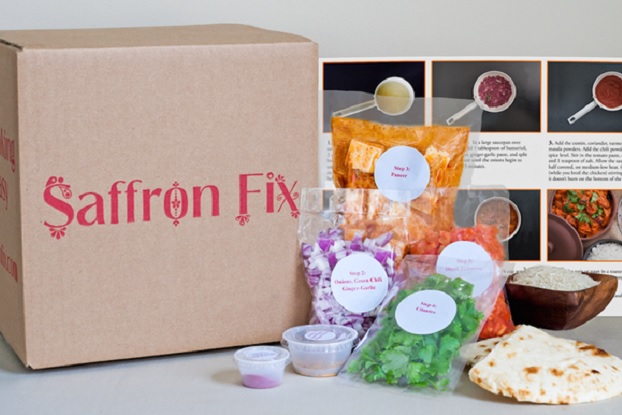
Moreover, when it comes to Indian cooking, although ingredients prevalent in the vastness of that cuisine are generally more easily available these days than they were about ten or fifteen years ago, for someone who’s new to Indian cooking, sourcing the necessary ingredients even in some urban centers or suburbs and exurbs is no easy task.
So, imagine my relief when I opened a Saffron Fix box. All required ingredients for two different dishes in one place, neatly packaged in their separate little containers or pouches, surrounded by ice packs, accompanied by recipe cards with instructions, and a separate sheet of paper with nutrition facts. Other than items such as oil, salt, cutting board, knife, and pots and pans that are usually within reach anyway, I did not need to step away from the counter next to the stove for anything.
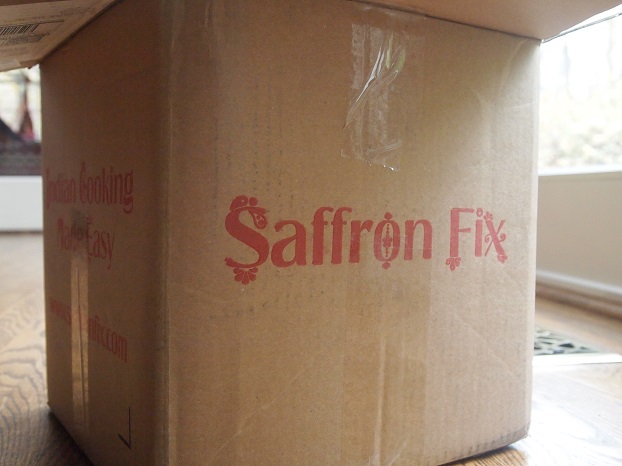
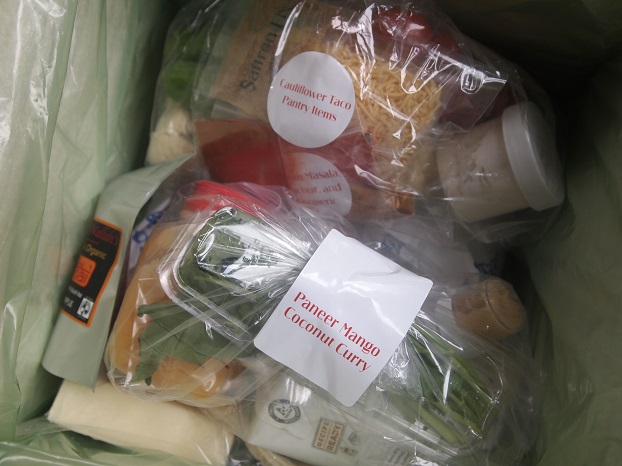
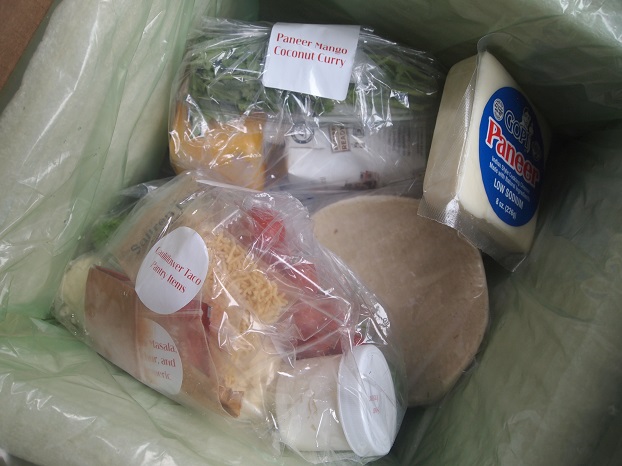
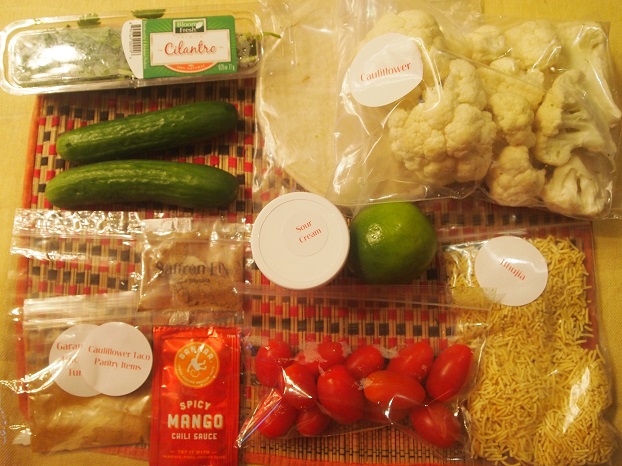
Over the span of a work-week, I made two vegetarian dishes, Paneer Mango Coconut Curry and Roasted Cauliflower Tacos. Both recipe cards came with the admonition to ‘Cook within five days,’ and both recipes bragged of an impressive and delightful 30-minute cooking time, a speed I will admit I cannot achieve most days.
Roasted Cauliflower Tacos
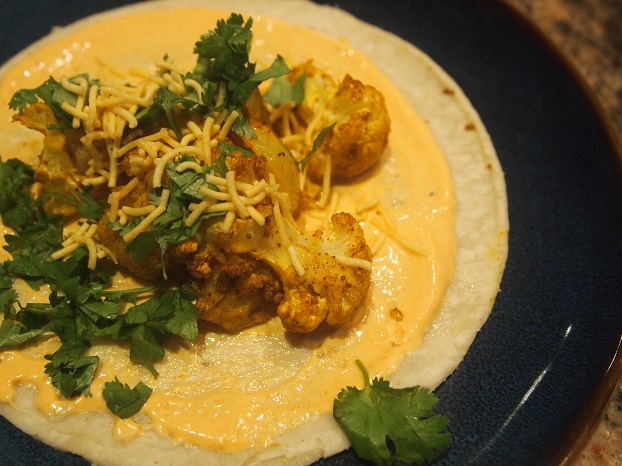
The Roasted Cauliflower Tacos, the more intriguing of the two, came with cauliflower florets, all necessary spices, spice powders and herbs, sour cream, bhujia (a savory fried lentil mix), grape tomatoes, cucumbers, lime and tortillas. The result was spiced cauliflower florets wrapped in tortillas smeared with a sauce of sour cream spiced with Indian mango pickle, a side of the tomato and cucumber salad, and garnished with the bhijua and cilantro. It took slightly less than 30 minutes to make from start to finish. The recipe said it made two servings, but we comfortably got three and all of it was gone in under 10 minutes.
“The recipe said it made two servings, but we comfortably got three and all of it was gone in under 10 minutes.”
Several ideas were new to me in this dish — the amchur (a spice mix derived from dried mangoes) powder used to spice up the cauliflower before roasting it in the oven, the Indian mango pickle sauce mixed with sour cream as a spread for the tortillas, and the ‘raita masala’ used to flavor the tomato/cucumber salad. All of these ideas worked well together to raise the flavors of the dish. The one small downside to the dish was the use of corn tortillas as wraps. I never warmed to corn tortillas for use in Indian dishes as they tend to leave a pasty aftertaste. I prefer the small naans that have made their way even into the mainstream grocery stores these days.
As with most households these days, an evening time crunch leading to abandoned cooking plans is par for the course at least once a week. Dinner ends up being a smorgasbord of leftovers dressed up in staples such as a bread or naan or fresh rice while grocery items shopped over the previous weekend continue on in the fridge or freezer. Knowing that this is a possibility with even ready-to-cook meal packages, I held off on cooking the Paneer Mango Coconut Curry until the very last day of the cook-by date to see if it would hold up. The ingredients remained fresh when stored in their original pouches in the fridge.
Paneer Mango Coconut Curry
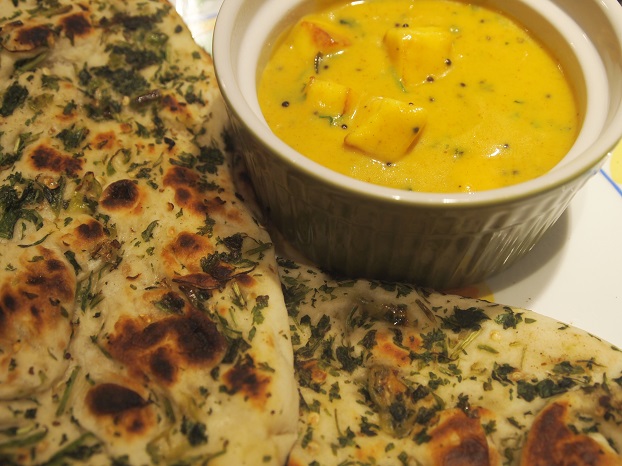
Again, the flavor combination was new — a curry of paneer, mango puree and coconut milk spiced with madras curry powder, a garlic ginger paste, dried red chilies and fresh curry leaves and cilantro. The result was a rich, flavorful base for the paneer and the rice it was meant to be served with. (I deviated a little from the original recipe; I roasted the paneer cubes in a few drops of oil before adding them to the curry base.) Most importantly, leftovers lived well in the fridge for another two days. The drudgery had gone out of the cooking but the feel of a home-made meal stayed behind.
“The drudgery had gone out of the cooking but the feel of a home-made meal stayed behind.”
According to the Saffron Fix website, vegetarian and non-vegetarian meal-kits with options for two ($49.95) or three recipes ($69.95) arrive every other week on a Thursday or Friday on a subscription plan. Alternatively, meal-kits, currently delivered to 21 states plus Chicago and Atlanta, are available to be purchased on a one-off basis. So, by the time you cook all the dishes you’ve received (by the end of the following week from the date of delivery), you will be charged for the next shipment. The company promises that the subscription plan is “flexible and customizable,” allowing patrons to cancel or shift shipments to subsequent delivery dates.
While I could picture myself turning to Saffron Fix during the weeks of the year when I know it is near-impossible to plan a home-made meal every day of the week, I can definitely imagine a very real present and a very near future in which millennials and gen-x and gen-y will have Saffron Fix on their phones much as they have their local pizza joint or Chinese take-out place on their contact lists. Is there a Saffron Fix app yet?
Additional Reading:
* * *
Sujatha Bagal is a Washington, D.C.- based freelance writer and blogger. Her essays, articles and stories have appeared in various online and print publications, including Pregnancy, Mint Lounge, ForbesLife India and The Smart Set (links available here). She is currently working with her mom-in-law on a cookbook featuring regional Karnataka cuisine. Find her on Twitter and Instagram.


















